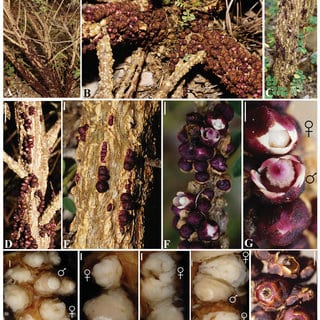IPPS Online Seminar Series July 07, 2021 at 3:00 PM GMT (8:00 AM Los Angeles, 10:00 AM Bogota/Brasilia, 11:00 AM New York/Santiago, 4:00 PM Abuja/London, 5:00 PM Amsterdam/Berlin/Cape Town, 6:00 PM Nairobi/Tel Aviv, 11:00 PM Beijing, 12:00 AM Tokio, 01:00 AM (next day) Canberra)
The Apodanthaceae comprises two genera and eleven endoholoparasitic species. The exclusively New World, monospecific Apodanthes parasitizes various Salicaceae, whereas the 10 species of the widespread Pilostyles parasitize a broad range of legumes. All Apodanthaceae are achlorophyllous and have undergone extreme morphological reduction resulting in the lack of root and shoot apical meristems, stems, and leaves. Their vegetative phase is reduced to a mycelium-like endophyte formed by strands of parenchymatous cells that are in close contact to the host vasculature. Floral development occurs entirely inside the host stems. The Apodanthaceae become apparent only when their tiny gregarious, mostly unisexual flowers emerge breaking through the host cortex. Our case study, Pilostyles boyacensis, has been chosen as a representative species of the genus, in order to study a number of structural traits and genomic fingerprints that help us to better understand its holoparasitic lifestyle; the species is found in dry inter-Andean valleys parasitizing Dalea cuatrecasasii (Fabaceae). We have sequenced both its genome and representative transcriptomes from the endophytic tissue of P. boyacensis growing inside the D. cuatrecasasii host stem, in mixed (PbE+D) host-parasite samples, as well as individual emerging preanthetic flowers (PbFl) and fruits (PbFr) of P. boyacensis. In this talk we will: (1) present genome content and structure, especially that corresponding to the highly reduced plastome, with some insights into the nuclear genome; (2) assess the evolution of shoot apical meristem (SAM)-related genes in the absence of a typical vegetative SAM; and (3) assess the evolution of flowering integrators and floral organ identity genes in this endoholoparasitic plant with intact floral transition. So far, our results have confirmed extreme plastome reduction, both in size and gene content, without broad scale changes in the mitogenome or the nuclear genome. Plastome reduction is highly conserved in African and Australian Pilostyles spp., which strongly suggests that the legume-Pilostyles endoholoparasitism was already in place before the Gondwana split. In addition, the endoparasitic lifestyle of Apodanthaceae appears to correlate with a substantial reduction in the transcriptomic machinery linked to initiation and maintenance of SAMs, whereas the genes involved in flower fate have remained intact. Finally, we have preliminary data that suggest the recruitment of host flowering signals to activate endogenous floral organ identity genes, similar to what has been observed in other parasitic plants. Additional studies are underway to address the same questions in Apodanthes casearieae in order to test common and convergent features during the evolution of the two members of the family Apodanthaceae, which has taken place in two unrelated hosts.
Natalia Pabón-Mora is based at the University of Antioquia in Colombia. Her research interests center around plant evo-devo and the genetic networks controlling flower and fruit development. Natalia Pabón-Mora also studies the genetic changes in hemi- and holoparasitic neotropical plants, currently with a strong focus on endoparasitic species belonging to the Apodanthaceae family. In 2008 and 2012, respectively, she received her Masters and doctoral degrees from The City University of New York and The New York Botanical Garden (USA). She has been awarded the Early Career Award from the Pan American Society for Evolutionary and Developmental Biology PanAm EvoDevo, the Katherine Essau Award and the Maynard Moseley Award by the Botanical Society of America.
